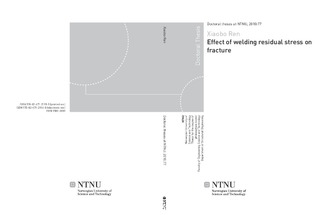| dc.contributor.author | Ren, Xiaobo | nb_NO |
| dc.date.accessioned | 2014-12-19T11:58:37Z | |
| dc.date.available | 2014-12-19T11:58:37Z | |
| dc.date.created | 2010-10-20 | nb_NO |
| dc.date.issued | 2010 | nb_NO |
| dc.identifier | 358071 | nb_NO |
| dc.identifier.isbn | 978-82-471-2115-3 (printed ver.) | nb_NO |
| dc.identifier.isbn | 978-82-471-2116-0 (electronic ver.) | nb_NO |
| dc.identifier.uri | http://hdl.handle.net/11250/236576 | |
| dc.description.abstract | Residual stresses are unavoidable in welded constructions. How to correctly predict residual stresses and assess their effect on structural integrity is a fundamental issue. One of the most difficult aspects in structural integrity assessment is to incorporate the effect of residual stresses in a safe manner, without making unduly conservative assumptions about the level of stress that may be present. Current structural assessment procedures typically assume upper bound residual stress solution, which can overestimate or underestimate the effect of residual stresses. The objective of this study is to fundamentally understand the effect of residual stresses on fracture behaviour and try to incorporate the effect into the integrity assessment procedure in a quantitative manner.
This study concerns an ideal problem. A large cylinder with a weld in the center was studied. The cylinder was simulated by a 2D plane strain modified boundary layer model with the remote boundary governed by the elastic K-field and T-stress. A sharp crack was embedded in the weld region. The eigenstrain method was employed to introduce a local tensile or compressive residual stress field into the finite element model. The concept of the study is to investigate the difference between the reference case and the case including residual stresses.
Residual stress-induced the crack-tip constraint has been investigated first. Based on the difference of the opening stress between the case with residual stresses and the reference case, a parameter R was defined to characterize the crack-tip constraint induced by residual stresses. The effects of external loading, material hardening, loading path and geometry constraint on R have also been studied. It has been found that the residual stress-induced crack-tip constraint is smaller for the case with higher geometry constraint.
Effect of residual stress on cleavage fracture toughness was investigated by using the cohesive zone model with a bilinear traction-separationlaw. Several cases were studied to understand the effect of residual stresses on the cleavage fracture toughness. Results suggest that the behaviour of residual stress is very similar to T-stress. Tensile residual stress compresses the plastic zone of the surrounding material and moves the plastic zone backward, which in turn reduces the cleavage fracture toughness. In contrast, the compressive residual stress enlarges the plastic zone and shifts the plastic zone forward, and enhances the cleavage toughness. The effect of residual stresses on cleavage fracture toughness has also been investigated for geometrically similar weld with different sizes, different damage parameters, hardening exponents and T-stresses.
Ductile crack growth resistance is important for assessing the structural integrity, and the effect of residual stresses on ductile crack growth resistance has also been studied. The study reveals that tensile residual stresses decrease the crack growth resistance while the compressive residual stresses have the opposite effect. With the increase of crack growth, the effect of residual stress tends to diminish. Under certain conditions, the effect of residual stresses on crack growth resistance curve is independent of the size of geometrically similar weld. Thus, a "master curve" can be obtained and applied for the integrity assessment. Effect of residual stress on the crack growth resistance also depends on the material hardening, initial void volume fraction and T-stress.
It has not been completed to incorporate the effect of residual stresses into the integrity assessment by a quantitative manner in this study. However, some guidelines were outlined in the thesis for future work. | nb_NO |
| dc.language | eng | nb_NO |
| dc.publisher | Norges teknisk-naturvitenskapelige universitet, Fakultet for ingeniørvitenskap og teknologi, Institutt for konstruksjonsteknikk | nb_NO |
| dc.relation.ispartofseries | Doktoravhandlinger ved NTNU, 1503-8181; 2010:77 | nb_NO |
| dc.title | Effect of welding residual stresson fracture | nb_NO |
| dc.type | Doctoral thesis | nb_NO |
| dc.contributor.department | Norges teknisk-naturvitenskapelige universitet, Fakultet for ingeniørvitenskap og teknologi, Institutt for konstruksjonsteknikk | nb_NO |
| dc.description.degree | PhD i konstruksjonsteknikk | nb_NO |
| dc.description.degree | PhD in Structural Engineering | en_GB |
